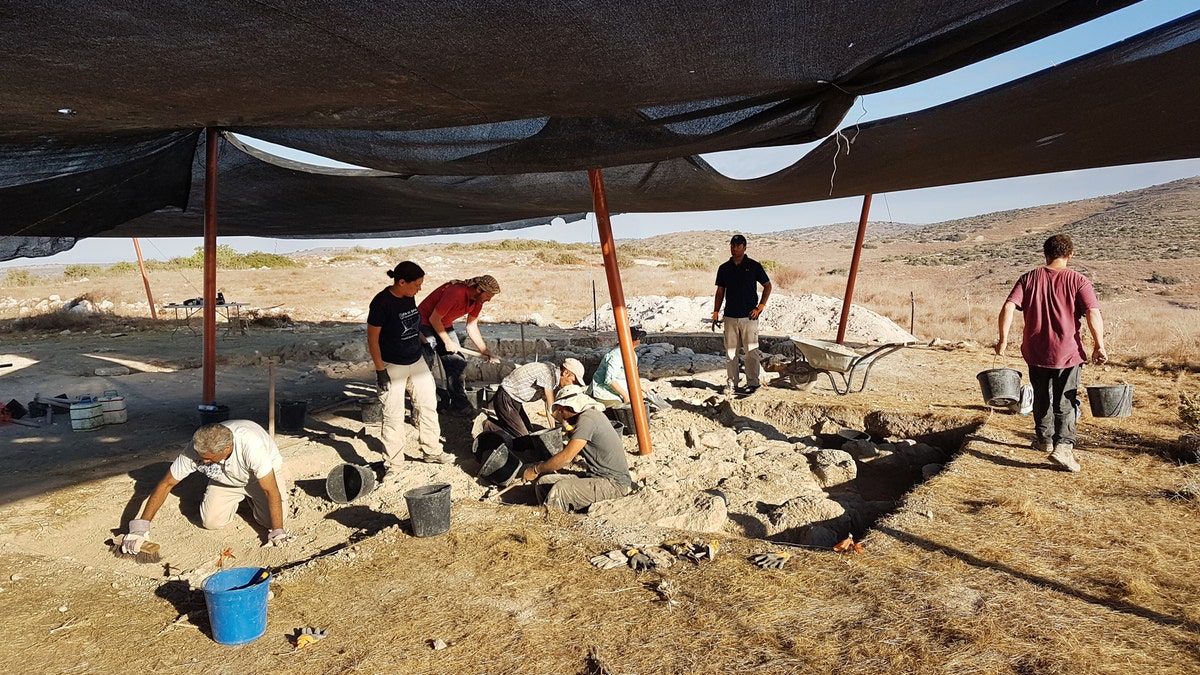
Area of the large structure, possibly a temple or palace, uncovered in the dig. (Photo: Dane Christensen)
Archaeologists have used a drone to locate a mysterious ancient structure in the heart of an Israeli military training area.
The 2,200-year-old structure, which may be a temple or palace from the ancient Idumean culture, was excavated by experts from the Israel Antiquities Authority and the Hebrew University of Jerusalem. The structure dates back to the Hellenistic period, when Greek influences were strong in the region.
An altar adorned with the image of a bull was found inside the structure at Horvat ‘Amuda, in the Lachish region of Israel. The Idumeans were a Semitic people originating in southern Jordan who settled in the Judean foothills.
RARE FIND AT KING SOLOMON'S MINES: ANCIENT PREGNANT WOMAN'S REMAINS
Archaeologists believe that the altar may have been dismantled during the area’s conquest by the Hasmonean dynasty during the second century B.C.

Remains of the structure indicate that it was intentionally dismantled, possibly by the Hasmoneans. (Photo: Dane Christensen)
“If this was indeed an Idumean palace or temple, it is a rare and exciting find – similar structures in this country can be counted on the fingers of one hand,” explained excavation directors Dr. Oren Gutfeld of the Hebrew University, and Pablo Betzer and Michal Haber of the Israel Antiquities Authority, in a statement.
A camera-equipped drone helped locate the structure. “This technology helped us choose where to focus our excavation probes, and, indeed, it very quickly emerged that this was in fact a unique discovery,” the archaeologists said.
AMAZING WESTERN WALL DISCOVERY: NEW SECTION, ANCIENT THEATER, UNCOVERED IN JERUSALEM
The archaeologists found two stone incense altars in one of the rooms within the structure. One of them, which bears the carved image of a bull, stands in what appears to be the façade of a temple adorned with magnificent columns. Describing the decorated altar as a rare find, experts think that the bull may represent a deity worshipped by the Idumeans.

Two cultic incense altars found in one of the rooms of the structure. (Photo: Michal Haber, Israel Antiquities Authority)
Pottery vessels were also found, as well painted bowls, juglets and oil lamps, according to the Israel Antiquities Authority and the Hebrew University of Jerusalem. Additionally, a number of underground spaces were found at the site, which were used as quarries or to house ritual baths, oil presses and dovecots. Hiding tunnels from the time of the Jewish revolt against the Romans were also found, one of which contained a cooking pot from the time of the Bar Kokhba revolt in the second century.
Students from Bar-Ilan University and volunteers from the U.S. participated in the excavation, which will continue in the spring.
NEW EVIDENCE DATES CHRIST’S TOMB TO ROMAN ERA, MATCHING HISTORICAL RECORDS
Experts are increasingly using technology to uncover ancient sites. Archaeologists, for example, harnessed spy satellite imagery and drones to help identify the site of an ancient lost city in Northern Iraq.

Archaeologists uncover the ancient structure. (Photo: Michal Haber, Israel Antiquities Authority)
The mysterious ancient structure at Horvat ‘Amuda is just the latest fascinating archaeological find in Israel. Earlier this week, new evidence dated Christ’s tomb in Jerusalem’s Church of the Holy Sepulchre to the Roman era, matching historical records.
Archaeologists also recently uncovered a stunning 1,500-year-old Christian mosaic in the ancient Mediterranean coastal city of Ashdod-Yam, now part of the modern city of Ashdod.
LOST ROMAN CITY THAT WAS HOME TO JESUS' APOSTLES FOUND, SAY ARCHAEOLOGISTS
Other finds include the skeleton of a pregnant woman, dating back 3,200 years, in Israel’s Timna Valley, at a place once called King Solomon’s Mines.

Examples of cultic vessels uncovered in one of the structure’s rooms. (Photo: Clara Amit, Israel Antiquities Authority)
In October, archaeologists in Jerusalem announced that they have uncovered a new section of the Western Wall that has been hidden for 1,700 years.
Some experts also believe they have found the lost Roman city of Julias, formerly the village of Bethsaida, which was the home of Jesus' apostles Peter, Andrew and Philip.
Follow James Rogers on Twitter @jamesjrogers




















